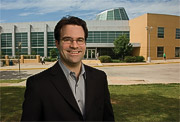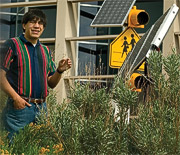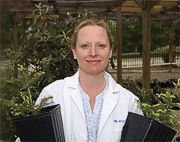 |
|||||||||||||||||

Discovering the Future
|
At 22, as one of the youngest researchers ever at the U.S. Department of Agriculture, Kelly Ivors studied organic methods to control a fungus that was devastating the U.S. hazelnut industry.
At 23, Kyle Holmes managed the installation of mechanical system piping on a $15 million building expansion as a project manager for Brandt Engineering Co. in Dallas. And at 26, Olga Dubois Lobban already had received her doctoral degree in physics — after graduating with a bachelor's degree at age 20 and working at a national laboratory, measuring the energy of subatomic particles in high-energy collisions. Ivors, Holmes and Lobban are just three alumni of UNT's Texas Academy of Mathematics and Science who are contributing their scientific and technical expertise to industries and laboratories. TAMS is one of the nation's leading programs for producing highly qualified researchers, especially important as the United States combats a shortage of citizens trained as scientists, mathematicians or engineers. Because of the unique hands-on experience TAMS provides its students, these scholars are well equipped to become successful professionals helping solve some of society's biggest issues. Sanjiv "Sonny" Harpavat ('94 TAMS), a pediatrician at Texas Children's Hospital in Houston, for example, says he's come full circle since his research experience at TAMS. Working in the laboratory of Ruthann Masaracchia, now a Professor Emeritus of biological sciences, he studied a protein carried by worms that causes starvation in infected children in Third World nations. "It was a great feeling for me, a high school student, to work on a problem related to the bigger picture of world hunger," says Harpavat, who was recognized in a national high school science competition. "TAMS helped me see the science side of medicine, and I got a Ph.D. in genetics and developmental biology." Later this year, Harpavat will begin a research fellowship focusing on childhood malnutrition. Providing opportunities TAMS — the nation's first accelerated residential program for gifted teens who take university courses to complete their first two years of college while earning high school diplomas — began 20 years ago as an experiment aimed at helping Texas' brightest teenagers get a head start on careers as physicians, engineers and science researchers. Students enter the academy as high school juniors, live in a residence hall and take regular UNT courses. After four semesters, each student has earned about 60 hours of college credit. More than 3,000 students have graduated from TAMS, and many of them now hold advanced degrees in mathematics, engineering or a science. Although the National Science Foundation reports that only 5 percent of U.S. bachelor's degrees are in engineering and only 12 percent are in mathematics and physical, life, environmental and computer sciences, the percentage of TAMS graduates declaring a major in one of these fields has risen steadily each year — from just under 60 percent for the first graduating students in 1990 to more than 80 percent for 2007 graduates. Alumni say the combination of college-level science courses and the chance to do research in university laboratories guided them into their careers. Holmes ('95 TAMS), who received the academy's first Distinguished Alumnus Award at its May commencement, says he couldn't pass up the opportunities that TAMS offered. "I was at a good high school, but no high school provides the breadth of courses that a college campus does," says Holmes, who as a mechanical engineer helped construct UNT's Pohl Recreation Center several years after graduating. Shortly after entering TAMS, Haley Hagg Lobland ('01 TAMS) began working in UNT's Laboratory of Advanced Polymers and Optimized Materials, directed by materials science Regents Professor Witold Brostow. During the next year and a half, she published two scientific articles and was recognized in a national competition for student research. "Doing research at such a young age and being successful at it elicited confidence in my capacity to conduct good scientific research," says Lobland, who recently returned to UNT to earn a doctoral degree and is guiding a new generation of TAMS students.
As a physical chemist at the National Renewable Energy Laboratory in Golden, Colo., John-David Rocha ('93 TAMS, '95, '02 M.S.) uses optical spectroscopy methods he first learned as a TAMS student working in the laboratory of Paul Marshall, professor of chemistry. Rocha studied physical chemistry, using mathematics and physics to understand chemical phenomena. His research at NREL may lead to advances in the storage of hydrogen used in fuel cells, which convert energy from a chemical reaction directly into electrical energy. "The ultimate goal is to have viable and practical use of hydrogen as a fuel source for vehicles," he says. Ivors ('90 TAMS), now an assistant professor of plant pathology at North Carolina State University, researches diseases that impact vegetables, ornamentals, burley tobacco and Christmas trees — the main crops of western North Carolina. She also evaluates fungicides used in farming them.
One of the first 56 students to graduate from TAMS, Ivors calls her class "risk takers." "I applied to TAMS because I wanted the opportunity to be around others who were interested in math and science," she says. "We were a tight-knit group." Rocha found an additional support system at UNT as a TAMS graduate. Choosing to stay to finish his bachelor's degree, he became one of the first students in the Ronald E. McNair Post-baccalaureate Achievement Program and continued his research with Marshall while earning a master's degree. The program helped prepare him for doctoral study. "I was the first in my family to go to a four-year university, and I hadn't considered graduate school before going to TAMS," says Rocha, who recently received his doctoral degree from Rice University. Making a difference Other alumni say they were able to pursue science, math or engineering careers because attending TAMS gave them a strong academic background and helped them be accepted to universities nationally known for science and math degree programs.
Lobban ('94 TAMS), now an assistant professor of physics at St. Mary's University in San Antonio, is continuing her research on calorimetry in high-energy physics and has also started to study liquid nitrogen as a possible vehicle fuel. This summer, she and a St. Mary's colleague will work with students to build an environmentally friendly concept vehicle. She says she would never have been able to enter the Massachusetts Institute of Technology for her bachelor's degree if she had not attended TAMS. "TAMS got me used to a campus environment and prepared me for the intensity of work I had at MIT," she says. Travis Williams ('95 TAMS) says he was accepted to the California Institute of Technology not just because of his grades at TAMS, but because Stephen Jackson, Regents Professor of mathematics and a Caltech alumnus, wrote him a recommendation. "I don't think I would have gotten into Caltech if I hadn't met him, and the TAMS preparation was so good that I had a significant advantage over other students during my first semester," says Williams, who graduated with honors from Caltech. He's now an assistant professor of chemistry at the University of Southern California. Lobland's contacts with faculty members benefited her years after leaving TAMS. Shortly before she graduated, she and three other students received Barry M. Goldwater Scholarships, considered to be among the nation's most prestigious scholarships for students planning mathematics, science and engineering careers. James Duban, director of UNT's Office for Nationally Competitive Scholarships, worked with her on the application and, years later, helped her win a $92,000 graduate fellowship from the U.S. Department of Defense. Lobland used the award to return to UNT and become a doctoral student in materials science. She works again in Brostow's laboratory and mentors current TAMS students who work in the lab — as she was mentored. "Encouraging them is an essential part of their learning and improves their perseverance," she says. Ivors agrees. "The academy gave me the self-confidence I needed to pursue a research career in science," she says. "It's interesting to see how the program has evolved. I feel very lucky I got into the academy when I did."
|
||||||||||||||||||||||||||||||||||||||||||||||||||||



